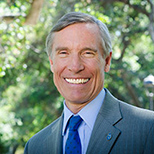October 20, 2014 — Editor’s note: This article is reprinted with permission from The Chronicle of Higher Education.
As a college president and chemist, I have worked throughout my career in areas connected to climate change. As an educator, I have written chemistry textbooks and regularly teach courses in which the most urgent issue is climate change. As a president, I frequently face decisions about investments in sustainable practices, whether green buildings (our most recent construction has been certified LEED platinum) or reductions in water and energy use, or curricular changes in support of our strong environmental-analysis major.
And yet on the topic of divestment of stock in companies that produce and market carbon-based fuels — an issue that is gaining attention on college campuses and in the news media — I am a profound skeptic. Why? Because we have passed the point for symbolic actions and need to take real steps to achieve change. Feel-good measures that have no effect on actual greenhouse-gas production are a diversion from the critical actions we must take before it is too late.
Many of those involved in the divestment movement say quite candidly that they do not expect divestment (even by major universities with much larger endowments than our own, and recently by our Claremont Colleges neighbor Pitzer College) to have an effect on the policies of the companies involved, but that this is one way of getting attention for the issue, to get on the front page of The New York Times.
Symbolic actions have their place. But at colleges and universities, our first goal is to educate students to be skeptical about simple claims and to weigh competing values.That is how I see the widely reported decision this year by Stanford University to “divest” in coal. What they actually announced was that they “will not make direct investments in publicly traded companies whose principal business is the mining of coal for use in energy generation.” After Stanford made the announcement, we looked at our own investments in the publicly available list of the top 100 coal companies and found that we do not have any investments in them. They are mostly unappealing companies that few have heard of. We could have made the same “divestment” announcement without making a single change in our endowment — or a dent in climate change.
Symbolic actions have their place. But at colleges and universities, our first goal is to educate students to be skeptical about simple claims and to weigh competing values. Then we encourage them to build on their values to make a difference in the world. That will be done most effectively in the area of climate change not by headline-grabbing divestment decisions at individual institutions, but by helping to build a coalition and elect public officials for whom climate change is a compelling and urgent issue.
Fifty years ago, just such a coalition was built on college campuses across the country. The Freedom Summer of 1964 was a courageous and highly effective movement to engage college students in the most compelling issue of their time: ensuring civil rights for African-Americans who had been systematically disenfranchised in the South. As we look at students’ efforts during that turbulent time, we see how they came together to organize a powerful movement that crossed racial, socioeconomic and age barriers to help change U.S. laws.
Within a few years, college students again mobilized, this time against the role of the United States in the Vietnam War. Their political actions helped pressure political leaders to finally end the nation’s involvement in the war and bring troops home.
As I look at the political landscape of the climate-change discussion today, I see many lessons we can take from Freedom Summer, the antiwar movement and the fight for our environment.College students also turned their attention to the growing scourge of environmental degradation, which was typified by toxic-waste dumps, oil spills, air pollution and rampant use of pesticides. They paved the way for the formation of a unique coalition that included Democrats and Republicans and people from every walk of life. On April 22, 1970, students held teach-ins on campuses across the country and were joined by millions of people who demonstrated in the streets for environmental protection. This historic political mobilization helped spur the creation of the Environmental Protection Agency and the passage of the Clean Air Act of 1970, with the Clean Water and Endangered Species acts coming soon after.
As I look at the political landscape of the climate-change discussion today, I see many lessons we can take from Freedom Summer, the antiwar movement and the fight for our environment. Much like today’s climate-change debate, with skeptics on both sides of the political aisle, these issues were not universally embraced by politicians from any party or in any part of the country. Many feared taking them on. But through the turbulent decades of student-organized political action, politicians across the country were forced to deal with the critical issues of their time, and to do so with haste.
I see a similar opportunity today for students, professors and others who believe in the pressing need to mobilize for climate change and in the process to force political change.
In my environmental-chemistry classroom, students grapple with the reality that we are doing an experiment on the globe (increasing carbon dioxide in the atmosphere at the fastest rate ever, and to levels not seen since dinosaurs walked the Earth), and that this is not an experiment that humans can repeat if the results are unpleasant. We venture into economics, discussing the cost of different approaches. We consider the challenges of politics: electing officials for two- or six-year terms when the problems we face will become acute in coming decades, not next year.
The students are passionate about climate change and committed to finding solutions. Our major in environmental analysis extends from science to policy and is closely coordinated with course offerings at the neighboring undergraduate institutions of the Claremont Colleges. Students study a wide variety of topics — water use, waste disposal, organic farming — but most of the material connects directly or indirectly to climate change.
Now is the time to move well beyond symbolism and ideologies and create a movement driven by young people.And this is where I see the future of the climate-change movement. It must again be a unique coalition, one of scientists, political activists, policy analysts, artists, business leaders, farmers, engineers and others. It must be driven by students who see the big picture and the future — students who are committed to pragmatic political action, much like those in decades past. The reality is that the implications of climate change are here. If we are not effective in our efforts to move political decision makers to act, the future for our students and the planet will be grim.
While there are many efforts in higher education that seek to solve climate change, from trying to foster carbon neutrality to divesting from fossil-fuel companies, we must rethink how colleges are dealing with this issue because, frankly, we simply have not had much success in changing corporate policies, bending the stubborn will of politicians, or capturing the hearts and minds of most Americans.
Now is the time to move well beyond symbolism and ideologies and create a movement driven by young people. Decades from now, they will be able to look back with a sense of achievement (and relief) and see their results. Let’s get on with that important work. ![]()
Editor’s note: The views expressed here are those of the author and not necessarily of Ensia. We present them to further discussion around important topics. We encourage you to respond with a comment below, following our commenting guidelines, which can be found here. In addition, you might consider submitting a Voices piece of your own. See Ensia’s “Contact” page for submission guidelines.
Ensia shares solutions-focused stories free of charge through our online magazine and partner media. That means audiences around the world have ready access to stories that can — and do — help them shape a better future. If you value our work, please show your support today.
Yes, I'll support Ensia!

Second, the divestment movement is the beginnings of what you suggest is most needed --"a unique coalition" led by students and including scientists, policy analysts, etc. Whether or not they win on individual campuses, students calling for divestment are learning to organize and make the kind of political change that we all understand is needed to address the climate crisis.
Furthermore, divestment is about more than symbolism, it is about investing consistent with one's values and recognizing the financial and moral risk associated with the fossil fuel industry.
What I find quite ridiculous is that Oxtoby highlights how easy it would have been to divest, but instead of doing it and providing symbolic support to a broader movement, he instead finds it better to stubbornly denounce symbolism and in doing so he ensures that students will continue to double down on the so-called 'distraction' of divestment. Why not just take the easy win?
When we published this piece, we thought it would kick up a debate. Encouraging discussion is core to what we're trying to do.
Hope others will weigh in and share their thoughts on this topic.
I personally feel that an "all of the above" approach is needed when it comes to addressing climate change.
Todd Reubold
Ensia director
I would ask that he address this issue broadly, and not attempt to limit the scope of his response by adopting a narrow definition of "personal".
As a matter of course, I believe that Ensia should require authors to stipulate up-front any potential conflicts of interest. Other leading venues (e.g. The Conversation) require this for ALL such essays.
I would also note a personal interest in fact-checking the author's response.
Of course, if he has no conflicts at all, then we should take his essay and views at face value. But if not...
I believe one has to look carefully as such discussions because, sadly, there are many incidences of 'wolves in sheep's clothing' in contemporary discussions about climate-change issues (see http://www.theecologist.org/campaigning/2426409/beware_environmental_wolves_in_sheeps_clothing.html).
I am interested in the need to shift blockages to action, particularly from those conservative political forces with close ties to fossil fuel corporations.
Here in Australia our major political parties get much of their funding from big fossil fuel mining companies. These corporations are being hurt by the divestment movement and are trying to fight back in the media without success. There is now a growing sense that the "donor largesse" of the past is coming to an end. I hope this will be a powerful motivator to clearer thinking by politicians about action on climate change.
In that regard, the divestiture movement is much like the protest over the Keystone pipeline. Even if protests were successful in blocking the project, Canada’s tar sands would find other ways to market, or they would be replaced in the marketplace by similarly dirty fuels.
Yet organizations such as 350.org have staked their brands on these issues. Maybe these protests will succeed in winning over a broad coalition to demand that meaningful action be taken to slow global warming. But it's hard to believe.
Wouldn’t it make sense to rally support for policies and decisions that are both symbolic AND effective?
I agree with the author. Divestment is a just an afterthought and a distraction from the underlying problems of carbon pollution.
http://www.theguardian.com/environment/2014/aug/27/ubs-investors-renewables-revolution
In my view a tactical approach to divestment is not only a powerful symbol, and means of mobilizing new supporters, but also it offers a credible threat, which could reinvigorate the efforts of 'socially responsible investors' to engage with corporations to shift their policies and practices. For too long, such 'engagement investing' has lacked teeth - coupled with a credible divestment movement it could become much more effective.